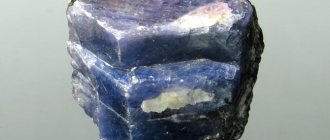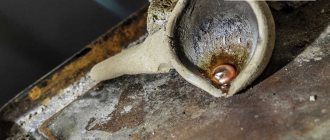Legal advice > Administrative law > What is illegal trafficking of precious metals, and what is the deadline?
It is difficult to find a person indifferent to jewelry. But gold, silver and precious stones not only attract the eye, but also have great value. This arouses interest in them not only among lovers of beauty, but also among criminals. Not all jewelry purchases take place in jewelry stores or workshops; sometimes people buy jewelry secondhand from friends. How can you avoid getting into trouble with the law in this case?
Features of the crime
Any transaction with jewelry that is not supported by documents is illegal.
By law, any operation with precious metals and stones, during which the jewelry changes ownership, must be documented with appropriate documents. This applies to the purchase, sale, gift, storage and transport of jewelry.
In everyday life, such conditions are often not met - grandmother’s jewelry can be passed on to her grandchildren without any documents. But, since these documents were not there initially, the law turns a blind eye to such situations. But it’s worth keeping receipts from the jewelry store to confirm who the owner is.
The circulation of native metals and precious stones is controlled much more strictly. Only licensed organizations can mine them and carry out any operations, and only on the condition that the state does not need these jewelry. For example, buying a silver ring in a store is a legal transaction if the seller issued a receipt, but illegal if there was no receipt. The purchase of a mineral containing silver will only become legal with the express permission of the state.
Simply put, individuals can freely buy products made of precious metals and stones, as well as products that contain precious metals (measuring instruments, radio components and others). It does not matter whether the product is in good working order. But unprocessed metal or stone, including those separated from the product (soldered-out elements of radio components, fragments of jewelry), cannot be in the hands of a private person - this violates the law.
Why is this happening? In the economy of each state there is the concept of a gold reserve, i.e. the quantities of precious metals and stones owned by the state that provide the value of the country's money. Illegal trafficking in precious metals removes them from the sphere of state supervision, especially when it comes to export abroad. Therefore, the long-term consequences of such operations are currency depreciation and economic disruption.
Exceptions
Some states of precious metals will not be considered as the subject of Article 191 of the Criminal Code of the Russian Federation. These include:
- Jewelry. They are understood as objects and various kinds of decorations that are made using artistic processing in its various manifestations. Precious metals are processed in combination with semi-precious, precious or counterfeit stones and other natural materials. Or they can be made entirely of precious metal;
- Household products made from precious metals. This means that such an item does not belong to the type of personal jewelry; items used in everyday life are used. This could be dishes, weapons, religious objects, etc.;
- Objects of art, antiquities or antiques, in the manufacture of which precious metals or stones were used;
- Scrap jewelry and other household items. These may be unusable, broken jewelry and items that can be recycled into other products;
- Gold leaf. These are thin films of gold that are used for decorative purposes;
- Discs for dental prostheses;
- State awards made using precious stones and metals;
- Collectible coins.
Important! In all of these cases, it is not taken into account how objects and decorations are made; it may also be a handicraft method. In addition, it does not matter whether the stamp is affixed or not. Clauses 3, 5, 7, 8 are an exception only for one-time transactions.
Responsibility for illegal trafficking
- Dgarmetalov. Depends on the value of the jewelry that became the object of the crime. The maximum punishment provided for by the Criminal Code is 5 years of compulsory labor or imprisonment for individuals, and up to seven years with a fine of up to a million rubles for a group of persons (two people are also considered a group).
- Stones. Responsibility for the turnover of stones is provided to the same extent. The likelihood of receiving the maximum sentence depends on the value of the stones with which the illegal operation was carried out.
- Pearls. Pearls are listed separately among precious stones, but responsibility for their turnover is the same as for other stones and metals. If pearls are not part of jewelry or a household product, they are the subject of a crime.
Qualifying features
Large size provided for in Part 1 of Article 191 of the Criminal Code of the Russian Federation is considered as qualifying signs of this act. Its amount is determined in the note to Article 170.2 of the Criminal Code and is equal to 2 million 250 thousand rubles.
Part two includes such qualifying criteria as the commission of an act by a group of persons by prior conspiracy or by an organized group.
Organized group:
- is sustainable;
- its members have united to commit one or more criminal acts;
- Each participant has their own role and responsibilities.
A group of persons by prior conspiracy:
- several persons (at least two) agreed to commit a crime;
- in this case, an agreement could be reached before the crime began.
Legislation and statistics
A special license is required for the manufacture and sale of jewelry made from precious metals.
The legislation provides for several ways of trading jewelry, depending on their condition and method of use. Native precious stones and metals are mined by special organizations that have a state license.
Part of what is mined is supplied to the state’s gold reserves, and only after this the mining organization can sell the products of its labor. She can sell them only to other organizations - factories for the production of various devices and jewelry, but not to individuals.
Jewelry made from precious stones and metals is manufactured and sold by licensed organizations. The buyer can be an individual or a company. Individuals can also donate and leave jewelry for storage. An important condition for the legality of the transaction is the presence of a check and documents confirming the transfer of property. The same applies to scrap jewelry - jewelry that has become unusable and requires repair.
Devices and household items containing precious metals and stones are freely sold and can be the property of a private individual or organization. The serviceability or malfunction of the device does not matter. A check is also important here, but control over such transactions is less strict.
All other operations are considered illegal and are prosecuted by law enforcement agencies. According to statistics for 2021, crimes related to jewelry trafficking accounted for about 0.3-0.5% of the total number of economic crimes in our country. However, this ratio has not changed since 2003. This is explained by the relatively stable situation in the country - if you look at the statistics from the early to mid-90s, the numbers will be much higher.
In addition, it is quite difficult to commit a crime in this area, especially in the area that concerns the mining and jewelry business. This is a fairly narrow sector of the economy in which reputation is of great importance, and attackers are forced to enter into large conspiracies or abandon criminal activities. A much more common crime is the theft of jewelry and its sale to pawn shops or through private jewelry workshops.
Storage and theft
According to Instruction No. 68, precious stones and metals are stored in premises that meet the requirements prescribed by law regarding technical strength and equipment with fire and security alarms.
Important! The premises and cabinets where these items are stored must be sealed, sealed, locked and handed over to security. Only responsible persons or a commission will be able to open them, with permission obtained from management. Taking into account the specificity of the criminal act under consideration, it is necessary to consider the type of theft that is associated with the performance of professional duties. These include fraud, theft, embezzlement or misappropriation.
Initially, signs are identified that are inherent in all types of theft, including the fact that the object is property.
The property has the following characteristics:
- has a certain value, that is, if things are seized that have no material value, no crime is formed;
- the property must belong to another person, this means that the culprit is a financially responsible person;
- the cost exceeds one established minimum wage.
The objective side is expressed in the confiscation and (or) circulation of someone else’s property by the perpetrator for his own benefit. When the culprit seized an item, but did not get the opportunity to dispose of it, it is considered as theft. The act is completed from the moment of seizure and the opportunity to dispose of the property at one’s own discretion. If we consider the theft of precious metals from production, then it is considered completed from the moment the metal left the production area and was taken out through the entrance.
If an employee is detained at a checkpoint, then the offense is assessed as attempted theft. If the stolen metal was kept by the culprit for a short time, then this provides grounds for classification under Article 191 of the Criminal Code of the Russian Federation under a set of crimes.
The subjective side is represented by direct intent.
Composition of the crime and types
The corpus delicti is a combination of factors that make it possible to determine an act as illegal and subject to punishment by law enforcement agencies. To do this, the following elements must be present:
- The subject of the crime, in this case, is a stone, metal or product. An illegal act is being committed against them;
- The object of the crime is a transaction or operation that is not legal, i.e. actual illegal action;
- Subjects, i.e. people who commit crimes.
The subject of the crime was discussed above.
For a transaction to be considered the object of a crime, there are several possible reasons:
- Lack of documents;
- Incorrect documentation;
- At least one of the parties to the transaction does not have the right to participate in it;
- The transaction involves an official who exceeds his authority;
- The items of the transaction themselves ended up in the hands of the current owner through illegal means (i.e., they were stolen or purchased illegally).
Citizens who are considered subjects of a crime must enter the age of criminal responsibility for especially serious crimes, i.e. 16 years. Both Russian citizens and foreigners and stateless people are subject to trial.
Types of crimes involving jewelry include illegal transactions, storage and transfer in violation of established rules.
Difficulties in qualifying illegal trafficking
The qualification of a crime has its own difficulties.
Like any other area, the circulation of precious stones has its own difficulties. As for jewelry, it is often stored at home without receipts and other documents, i.e. Formally, their storage is illegal. They are also often inherited within the family or given without paperwork.
All such cases are formally illegal transactions and illegal storage. In fact, they are carried out voluntarily, and no one’s interests are infringed upon, i.e. there are no grounds to initiate a criminal case.
The same applies to instruments and radio components. Gold and platinum are used to make some of their elements. The content of precious metals is extremely small, and not all radio amateurs have an idea of which part is made of platinum. The use of such devices is legal, as is their repair. However, if a radio amateur solders gold-containing parts, he already becomes a criminal. But the difficulty is that in order to bear criminal liability, he must be aware of the gold or platinum content, and it is almost impossible to prove this fact.
As for nuggets, a simple layman who has no geological knowledge can easily mistake a nugget for a stone that has no value, keep it or give it as a gift. Formally, these actions are illegal - they are storage and operations with native stones and metals, which cannot be performed by a private person. Therefore, lovers of rare and beautiful minerals expose themselves to serious risk.
Even jewelers who store substandard metal in their workshops, i.e. not suitable for use for decoration, they do so illegally. You can avoid liability by making a simple piece of jewelry out of it, for example, a ring or bracelet with an ornament - then it will be a piece of jewelry, the storage of which is not prohibited.
Who are they, black miners?
Even in Rus' there were people who searched for precious metals without having any permits. However, this is not surprising, because at all times people wanted to live better, provide for their families and bring home a decent income.
But, setting out on a journey for a better future, do not forget that in our country such activities are considered illegal. This means that the recovered gold will not be so easy to sell.
Many people who decide to search for Au prefer to work not for themselves, but in a group. That is, a certain organization that has a license recruits people and takes them to the site. They work there, look for gold, hand it over to a representative of the organization and receive money for it. Accommodation and food are paid by the employer. But not all miners are satisfied with the working conditions they are offered; some prefer to work for themselves.
There are several reasons for this, but by choosing this path, a person may encounter certain difficulties:
- You will have to work in traveling conditions.
- Do not use expensive equipment.
- Without a license, problems with the law may arise.
When choosing a place to work, it is worth considering that no one will undertake to provide the conditions: food, water and other benefits of civilization are the concern of the prospector who goes to develop the next vein. You can simply get lost in the forest or become a victim of an attack by unfriendly colleagues.
Since when trying to develop another deposit one may encounter not only prospectors who are not so well equipped, but also thieves, many prospectors do not take equipment with them.
And, of course, if there are no documents to search for precious metal, problems may arise with law enforcement agencies. All gold that a person washed in the river or dug up in the sand is subject to confiscation. And the miner faces criminal or administrative liability.
Gold mining may be under the control of criminals, and this is also worth considering. The prospect of meeting bandits in the forest will not please anyone.
If you read articles on the Internet, you can come across conflicting information that will tell you how people found nuggets and they didn’t get anything for it. But there is also information that those involved in the extraction of precious metals at the mines received punishment for this.
Typically, miners who mine the yellow metal illegally are called “predators.” This term appeared even before the revolution, and was applied to those citizens who were looking for Au deposits, not paying attention to state prohibitions. Naturally, all predators are looking for “that gold mine” and dream of finding untold riches. But even with this kind of find, when he allegedly became rich instantly, the miner will not be able to sell the mined gold without problems.
The largest number of people involved in illegal gold mining is in South Africa. Predators in this country work for pennies; they cannot sell everything they mined in Africa, and for this reason they are forced to sell the precious metal at a ridiculous price.
While people suffer from hunger and receive pennies for their hard work, the South African treasury suffers huge losses due to illegal Au mining. The losses are truly enormous, since Africa is one of the leaders in metal mining, and predators account for an impressive amount of gold.
But not only in South Africa, citizens earn their living in this way. The search and development of deposits is of interest to residents of Kazakhstan, Russia, Mongolia and Asia.
Predators work with a tray, a shovel and other tools; the equipment has remained virtually unchanged for hundreds of years. But, despite all the difficulties, people still go in search of precious metals. While legalization of mining could solve a lot of problems.
What is the benefit of issuing licenses to individuals:
- the unemployment rate in some regions of our country will decrease;
- the volume of precious metal production will increase;
- will help the state profit from the work of black miners;
- will contribute to the development of some regions.
Naturally, as a result of the economic crisis, many people are left without work and cannot provide for their families or earn decent money. This pushes prospectors to illegal mining. If the state issued licenses, then the unemployment rate would decrease, since miners would mine Au legally, that is, they would have an official source of income and pay taxes.
In terms of Au production volumes, our country today ranks sixth in the world. Naturally, if prospectors were searching for and developing veins with the permission of the state, and the gold found in rivers and streams was also taken into account, then Russia would occupy a completely different place in the list of leaders.
Neither the country nor its citizens profit greatly from the illegal mining and sale of Au. But if the legislation worked on this issue, and the state began to issue licenses, then the volume of those investments that pass by the treasury would significantly decrease.
Today the situation is such that many people, in search of a good job and a decent salary, flock to large cities, because the standard of living is higher there. There is an outflow of population from the regions of Siberia and the Far East. If we legalize the activities of miners, then it will make sense for people to go to various regions of our country for gold. This will contribute not only to the influx of population to remote areas, but also to their further development.
Work in a mine is hard and dangerous, and a person who works illegally risks not only his life and health. He has a real chance to give up his freedom and get a prison sentence.
How is the investigation into illegal trafficking of precious metals going?
The investigation begins with the fact of contacting law enforcement agencies. This is done by a witness or victim of the actions of attackers. If no one’s interests have been infringed or no one knows about the transaction or storage, then there are no grounds for initiating a criminal case, and the investigation will not begin.
The second thing that is necessary for the investigation is the subject of the crime, i.e. precious stones or metals. If a deal was made, then they must be somewhere, and discovering their whereabouts is a key point in the investigation. When the subject of a crime is discovered, it is removed from the storage location in compliance with the appropriate procedures. Then the materials are sent for examination, and only after receiving its results can the investigative authorities demand documents about the transaction.
The last stage is determining the authenticity and legality of the documents themselves. If they do not comply with the rules established by law, then the transaction is considered illegal, and its participants are considered criminals.
At any of these stages, the case may be closed due to the inability to move to the next stage of the investigation:
- At the application stage - if no one contacted the investigative authorities or the applicant refused the application;
- At the stage of searching for jewelry - if they were not found or were seized without paperwork;
- At the examination stage - if the materials were recognized as not subject to special accounting, namely: They are not jewelry;
- Not suitable for jewelry processing;
- Artificially grown;
In any case, the wording would be to close the case for lack of corpus delicti.
Punishment
The punishment depends on the severity of the crime.
The article of the Criminal Code, which establishes liability for illegal transactions with precious metals, provides for the following types of punishment:
- Mandatory work;
- Prison term;
- Fine.
Compulsory work is assigned for a period of up to 5 years, there is no lower limit. The duration depends on the damage caused to the state's economy. Assigned to both individuals and members of an organized group.
The prison term lasts up to 5 years for single criminals and up to 7 years for group members. It also depends on the severity of the crime. There is no lower limit. Appointed as an alternative to compulsory work.
The fine is the income of the convicted person for 3 years (maximum - 500,000 rubles), if he committed the crime alone, or income for 5 years (maximum - 1 million rubles) for group members. No lower limit has been established. It may be in addition to a prison sentence or compulsory labor, an alternative to other types of punishment, or not assigned at all.
The article indicates that a transaction worth more than 1.5 million rubles is considered to be a particularly large transaction. The penalty indicated as the maximum is awarded in such cases. If the damage to the state was not so catastrophic, the judge has the right to impose a more lenient punishment. Including a suspended sentence.











